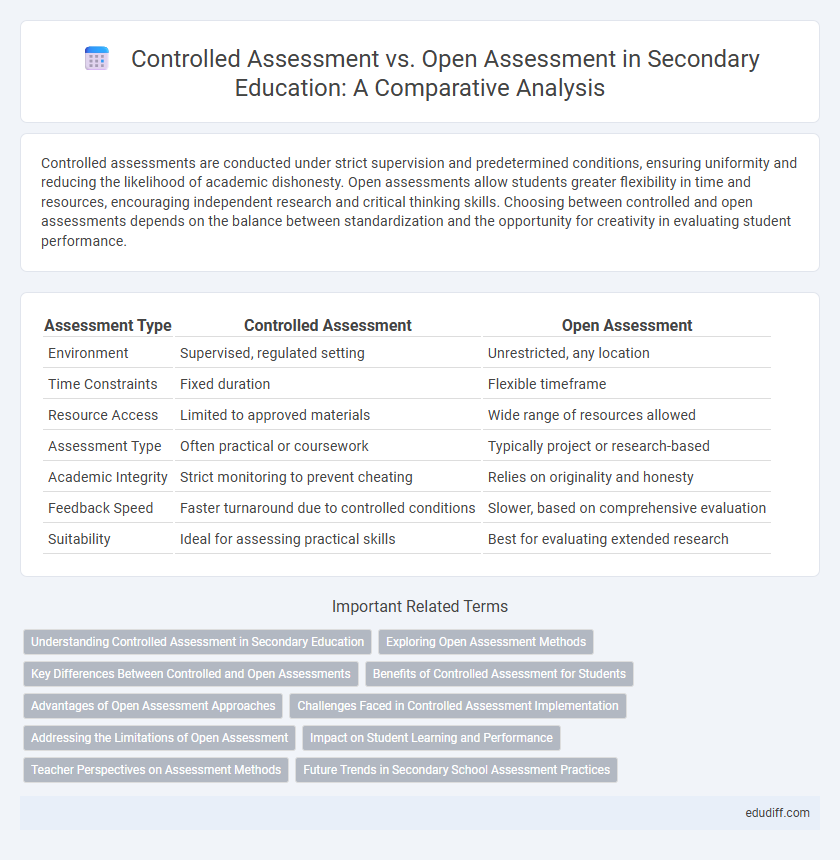Controlled assessments are conducted under strict supervision and predetermined conditions, ensuring uniformity and reducing the likelihood of academic dishonesty. Open assessments allow students greater flexibility in time and resources, encouraging independent research and critical thinking skills. Choosing between controlled and open assessments depends on the balance between standardization and the opportunity for creativity in evaluating student performance.
Table of Comparison
| Assessment Type | Controlled Assessment | Open Assessment |
|---|---|---|
| Environment | Supervised, regulated setting | Unrestricted, any location |
| Time Constraints | Fixed duration | Flexible timeframe |
| Resource Access | Limited to approved materials | Wide range of resources allowed |
| Assessment Type | Often practical or coursework | Typically project or research-based |
| Academic Integrity | Strict monitoring to prevent cheating | Relies on originality and honesty |
| Feedback Speed | Faster turnaround due to controlled conditions | Slower, based on comprehensive evaluation |
| Suitability | Ideal for assessing practical skills | Best for evaluating extended research |
Understanding Controlled Assessment in Secondary Education
Controlled assessment in secondary education involves a structured evaluation process where students complete tasks under supervised conditions to ensure authenticity and fairness. This method emphasizes consistent monitoring, limiting external assistance and time constraints, which aids in accurately measuring individual student performance and understanding. Compared to open assessments, controlled assessments reduce opportunities for academic dishonesty and provide reliable data on student knowledge application within the curriculum.
Exploring Open Assessment Methods
Open assessment methods emphasize flexibility and student autonomy, allowing diverse ways to demonstrate understanding beyond traditional exams. They foster critical thinking, creativity, and real-world application by incorporating projects, presentations, and digital portfolios. This approach aligns with modern educational goals by promoting continuous learning and personalized feedback in secondary education.
Key Differences Between Controlled and Open Assessments
Controlled assessments feature strict supervision, fixed timeframes, and regulated conditions to ensure academic integrity, whereas open assessments offer flexibility in time, location, and resources, fostering independent learning. Controlled assessments emphasize uniformity and standardized evaluation, while open assessments prioritize creativity and self-directed study. The key difference lies in the balance between oversight and autonomy in assessment execution and assessment criteria.
Benefits of Controlled Assessment for Students
Controlled assessment provides students with a structured environment that reduces the risk of plagiarism and ensures academic integrity, leading to fairer evaluation. This method allows close monitoring by teachers, offering timely feedback and support to enhance learning outcomes. Students benefit from clear guidelines and consistent conditions, which help reduce anxiety and improve performance reliability.
Advantages of Open Assessment Approaches
Open assessment approaches enhance student engagement by allowing greater flexibility and creativity in demonstrating knowledge. They provide opportunities for real-world application and critical thinking, improving deeper learning outcomes. These assessments reduce pressure and academic dishonesty, fostering a more authentic evaluation of student abilities.
Challenges Faced in Controlled Assessment Implementation
Controlled assessment implementation faces challenges such as managing strict supervision requirements, which place significant demands on both instructor resources and facility availability. Ensuring academic integrity proves difficult due to potential opportunities for misconduct under confined testing conditions. Additionally, logistical complexities arise from scheduling assessments within limited timeframes, causing disruptions to regular teaching activities.
Addressing the Limitations of Open Assessment
Open assessments often face challenges such as inconsistent evaluation standards and increased opportunities for academic dishonesty. Controlled assessments mitigate these issues by providing structured environments that ensure standardized conditions and more reliable measurement of student performance. Implementing controlled assessments enhances fairness and accuracy in evaluating secondary students' knowledge and skills.
Impact on Student Learning and Performance
Controlled assessments provide a structured environment that ensures consistency and fairness, enabling accurate measurement of student knowledge and skills under exam conditions. Open assessments encourage independent learning and critical thinking by allowing students to utilize resources and demonstrate deeper understanding over time. The balance between controlled and open assessments significantly influences student engagement, retention, and the development of higher-order cognitive abilities.
Teacher Perspectives on Assessment Methods
Teachers often view controlled assessments as more reliable for gauging student understanding due to standardized conditions and reduced opportunities for academic dishonesty. Open assessments are praised for encouraging critical thinking and real-world application, offering insights into students' creative problem-solving skills. Many educators highlight the balance between structured evaluation and flexibility as key to effectively measuring student performance in secondary education.
Future Trends in Secondary School Assessment Practices
Future trends in secondary school assessment emphasize a shift from controlled assessments to more flexible, open assessments that promote critical thinking and creativity. Digital tools and AI integration enable personalized feedback and real-time performance tracking, enhancing student engagement. Embracing open assessments supports the development of 21st-century skills, preparing students for higher education and the evolving job market.
Controlled assessment vs Open assessment Infographic

 edudiff.com
edudiff.com